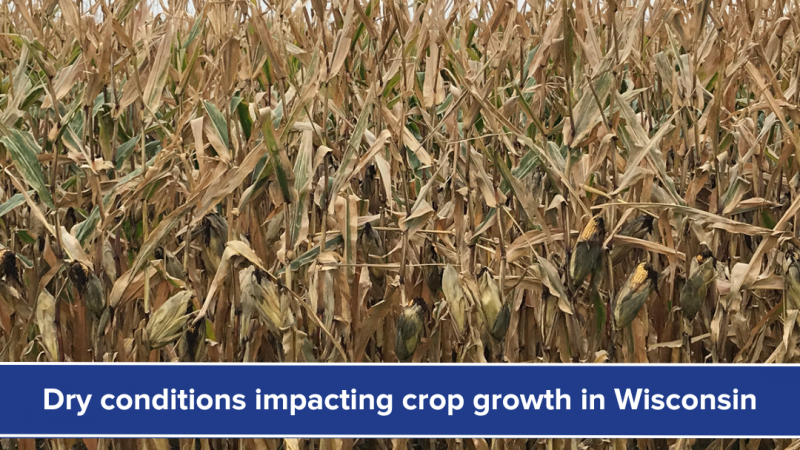Widespread drought conditions are hurting some crops in the state, according to the latest report from the USDA’s National Agricultural Statistics Service.
The federal agency’s latest crop progress report, produced in cooperation with DATCP, covers the week ending June 18. It shows moisture levels in both topsoil and subsoil have been declining throughout the month, as nearly half of the state is currently experiencing drought conditions.
“Although some precipitation was received in areas, dry conditions are reported to be affecting row crop growth and the growth of the second hay crop,” report authors wrote.
The National Integrated Drought Information System website shows 4.3 million Wisconsin residents are currently living in areas of drought. That number has increased by 36.7 percent since last week.
And while 44.6 percent of the state is “abnormally dry,” 46.2 percent of the state is in a moderate drought. That includes much of southern Wisconsin and part of the state’s northwestern region. Last month was the state’s fourth driest May on record, based on data going back to 1895, the federal site shows. Total precipitation was 1.59 inches for the month, which is 1.95 inches lower than normal.
Despite the challenging conditions, overall crop growth for corn, soybeans, oats and winter wheat has proceeded ahead of the five-year average on a statewide basis.
The USDA report shows 94 percent of the corn crop has emerged, which is five days ahead of last year and four days ahead of the average. Meanwhile, 94 percent of the soybean crop has also emerged, 9 days ahead of last year and 12 days ahead of the average. And 95 percent of the oat crop has emerged and 44 percent of that crop was headed — a sign of maturity for the plant — which is 10 days ahead of last year and six days ahead of the average.
Still, Wisconsin Farm Bureau Federation Vice President Joe Bragger warns that continued drought conditions could pose a serious problem for farmers in the state. In an interview yesterday, he said his own farm in Buffalo County is running “terribly behind” due to limited rainfall in western Wisconsin.
“We typically sell our second crop to a neighbor. This year, we had to harvest it because we’re worried about if we’ll have enough forage to feed our animals. And what we harvested … was half the yield that we normally would have,” he said. “So the effects are already happening.”
But he also noted modern farming practices, such as no-till farming and cover crops, and crop genetics are helping to reduce the impact of the drought. He explained the corn he’s planting has been modified to handle drier
weather.
“That’s helping us tremendously,” he said. “So agriculture has evolved a long way. This drought would be absolutely devastating 30 years ago … Agriculture has come a long way in water conservation.”
See the USDA report: https://www.nass.usda.gov/Statistics_by_State/Wisconsin/Publications/Crop_Progress_&_Condition/2023/WI-Crop-Progress-06-20-23.pdf
See the NIDIS site: https://www.drought.gov/states/wisconsin



